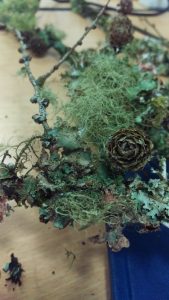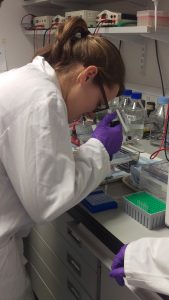
Hello,
Another month gone already. With time and patience I’m slowly gaining confidence in my identification skills, just in time for Phoebe to leave me to fend for myself. Though I will be sending her occasional pleas for help as I encounter wonderful and new species that I can’t key out. I’ve learnt a lot in the past few months, in no small part because of Phoebe, I am really going to miss her, though I expect visits and more lemon biscuits!
This month I went on another course run by Brecon and Powys Biodiversity Information Centre with Phoebe (they’re free and awesome – you can find them here: https://www.bis.org.uk/diaryevent). The course was looking at lichens, run by Alan Orange. First we had a presentation on lichen basics and ecology (a whole new world for me), then we went on a walk around the lovely Garwnant Natural Resources Wales Reserve to find our lichens. We then brought them back to identify using the ID books and keys we were given (fantastic resources that give me no excuse to not get out and record lichens!). It was tricky but the experience of working through keys and having your identifications checked by an expert gives you some confidence and I left inspired to try and pay more attention to the little green things. I can’t recommend these courses enough to learn more about the natural world and get into a new group!
I also had the fantastic opportunity to go and visit the laboratories at Science and Advice for Scottish Agriculture (SASA) with Phoebe. We visited Katherine Lester who is leading a project developing molecular tools for identification of the insect vectors of Xylella fastidiosa. Xylella fastidiosa is a bacterium that causes disease in crop plants by invading and sometimes cutting off their water supply. As leafhoppers are vectors for this disease-causing bacterium, work in identifying which species are responsible for the spread of this disease may help prevent breakouts in the future (the disease hasn’t reached Britain yet). We spent the week carrying out PCR in-between lots of tea breaks and then sequencing the DNA from some of the specimens we brought up (some of which aren’t on the database yet). Hopefully there will be further collaborations using molecular and morphological techniques to gain a greater understanding of this little-known group.
March was also Phoebe’s last month at the museum. She has been a wonderful teacher and I’m very lucky to have had her around while I was finding my feet. I’m sure she will go on to new exciting things. I’m starting to get excited about summer, doing fieldwork and using the identification skills I’ve built at the museum on my own samples.
I would like to thank TCV for this opportunity, NMW for supporting me and the Esmee Fairburn Foundation for supporting the Natural Talent Trainee scheme. This is an incredible learning experience which I’m very grateful for.


